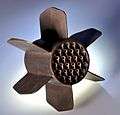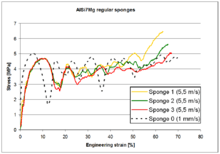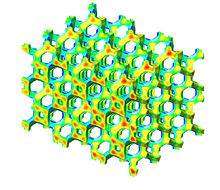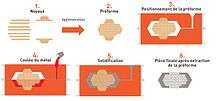Metal foam


A metal foam is a cellular structure consisting of a solid metal, frequently aluminium, as well as a large volume fraction of gas-filled pores. The pores can be sealed (closed-cell foam), or they can form an interconnected network (open-cell foam). The defining characteristic of metal foams is a very high porosity: typically 75–95% of the volume consists of void spaces making these ultralight materials. The strength of foamed metal possesses a power law relationship to its density; i.e., a 20% dense material is more than twice as strong as a 10% dense material.
Metallic foams typically retain some physical properties of their base material. Foam made from non-flammable metal will remain non-flammable and the foam is generally recyclable back to its base material. Coefficient of thermal expansion will also remain similar while thermal conductivity will likely be reduced.[1]
Although there is a very large number of patents describing feasible topological structures, constitutive materials, and production methods, metal foams cannot be considered a commodity and relatively few commercial producers are available worldwide of either closed or open cell foams.
Open-cell

Open celled metal foams, also called metal sponges,[2] have a wide variety of applications including heat exchangers (compact electronics cooling, cryogen tanks, PCM heat exchangers), energy absorption, flow diffusion and lightweight optics. Due to the high cost of the material it is generally used in advanced technology, aerospace, and manufacturing.
Extremely fine-scale open-cell foams, consisting of cells smaller than visible to the naked eye, are used as high-temperature filters in the chemical industry.
Metallic foams are used in the field of compact heat exchangers to increase heat transfer at the cost of an additional pressure drop.[3][4][5] However, their use permits substantial reduction in the physical size of a heat exchanger, and so fabrication costs. To model these materials, most works uses idealized and periodic structures or averaged macroscopic properties.
Metal sponges have very large surface area for their weight, so catalysts are often metal sponges, such as palladium black, platinum sponge, spongy nickel, etc.
(Sometimes a metal such as osmium or palladium hydride is metaphorically called a "metal sponge" because it soaks up hydrogen "like a sponge soaks up water").[6]
Manufacturing routes
Open cell metal foams can be manufactured by several ways, especially through foundry or powder metallurgy. In the powder method, "space holders" are needed; as their name suggests, they give space to the open pores and channels during or after the foam making process. In casting processes, foams are made by replicas of open-celled polyurethane foams used as a skeleton.
Closed-cell
Closed-cell metal foam was first reported in 1926 by Meller in a French patent where foaming of light metals, either by inert gas injection or by blowing agent, was suggested.[7] The next two patents on sponge-like metal were issued to Benjamin Sosnik in 1948 and 1951 who applied mercury vapor to blow liquid aluminium.[8][9]
Closed-cell metal foams have been developed since about 1956 by John C. Elliott at Bjorksten Research Laboratories. Although the first prototypes were available in the 50s, commercial production was started only in the 90s by Shinko Wire company in Japan. Closed-cell metal foams are primarily used as an impact-absorbing material, similarly to the polymer foams in a bicycle helmet but for higher impact loads. Unlike many polymer foams, metal foams remain deformed after impact and can therefore only be used once. They are light (typically 10–25% of the density of an identical non-porous alloy; commonly those of aluminium) and stiff, and are frequently proposed as a lightweight structural material. However, they have not yet been widely used for this purpose.
Closed-cell foams retain the fire resistant and recycling capability of other metallic foams but add the ability to float in water.
Manufacturing routes
Metal foams are commonly made by injecting a gas or mixing a foaming agent into molten metal.[10] Under certain circumstances metallic melts can be foamed by creating gas bubbles in the liquid. Normally, gas bubbles formed in a metallic melt tend to quickly rise to its surface due to the high buoyancy forces in the high-density liquid. This rise can be hampered by increasing the viscosity of the molten metal, either by adding fine ceramic powders or alloying elements to form stabilizing particles in the melt or by other means. Metallic melts can be foamed in one of three ways:
- by injecting gas into the liquid metal from an external source;
- by causing an in-situ gas formation in the liquid by admixing gas-releasing blowing agents to the molten metal;
- by causing the precipitation of gas which was previously dissolved in the liquid.
In order to stabilize the molten metal bubbles, high temperature foaming agents (nano- or micrometer- sized solid particles) are required. The size of the pores, or cells, is usually 1 to 8 mm. When foaming or blowing agents are used, they are frequently mixed to the metal in the solid state at a powder form. This is the so-called "powder route" of foaming and it is probably the most established (from an industrial standpoint). After metal (e.g. aluminium) powders and foaming agent (e.g.TiH2) have been mixed, they are compressed into a compact, solid precursor, which can be available in the form of a billet, a sheet or a wire. Production of precursors can be done by a combination of materials forming processes, such as powder pressing,[11] extrusion (direct[12] or conform[13]), flat rolling.[14]
Composite
Foams formed from hollow beads of one metal within a solid matrix of another, such as steel within aluminium, have been formed in the laboratory, and are showing 5 to 6 times greater strength to density ratio and over 7 times higher energy absorption than previous metal foams.[15]
Stochastic and regular foams
Stochastic
A foam is said to be stochastic when its porosity distribution is random. Most foams are stochastic because of their method of manufacture:
- Foaming of liquid or solid (powder) metal .
- Vapor deposition (CVD on a random matrix )
- Direct or indirect random casting of a mold containing beads or matrix.
Regular
A foam is said to be regular when its structure is ordered. One of the technologies developed to produce regular foams is by CTIF.[16][17] This is a direct molding method in which molding produces a foam with open and regular pores. Alternatively, regular metal foams can be produced by additive manufacturing processes such as selective laser melting (SLM).
Plates are used as casting cores. Their shape is customized for each application. This manufacturing method allows for "perfect" foam, so-called because it satisfies Plateau's laws and has conducting pores of the shape of a truncated octahedron Kelvin cell (body-centered cubic structure).

Direct molding foundry can produce complex shapes, including massive portions and foam.
Regular foams gallery
-

Heat sink with copper foam
-
Crash box including Aluminium foam
-

Aluminium foam with big porosity
-

Aluminium foam with aluminium sheet
-

Header - steel metal foam
Applications
Design
Metal foam can be used in product or architectural composition.
Design part gallery
-

machined metal foam
-
Design heatsink with regular foam[1]
-

coffee table with large pored aluminium
- ^ ALVEOTEC - Actualités - LOUPI Lighing launches his new metal foam heatsink for lighting application_66.html. Alveotec.fr. Retrieved on 2013-12-03.
Mechanical
Orthopedic uses
Foam metal has been used in experimental prosthetics for animals. In this application, a hole is drilled into the bone and the metal foam inserted letting the bone grow into the metal for a permanent connection. For orthopedic application, foams from metals such as tantalum or titanium are often used, as these metals exhibit high tensile strength and corrosion resistance with excellent biocompatibility.
Clinical studies on mammals
A notable example of clinical use of metallic foam is with a Siberian Husky, named Triumph, whose back legs received foam metal prostheses. Studies on mammals have shown that porous metals, such as titanium foam, may allow the formation of vascular systems within the porous area.[19]
Orthopedic use in humans
More recently, orthopedic device manufacturers have started producing devices that use foam construction or metal foam coatings[20] to achieve the desired levels of osseointegration.[21][22][23]
Automobiles
Metallic foams are currently being looked at as a new material for automobiles. The main goal of the use of metallic foams in vehicles is to increase sound dampening, reduce the weight of the automobile, and increase energy absorption in case of crashes, or (in military applications) to combat the concussive force of IEDs. As an example, foam filled tubes could be used as anti-intrusion bars.[24]
The metallic foams that are currently being looked at are aluminium and its alloys due to their low density (0.4–0.9 g/cm3). These foams have a high stiffness, are fire resistant, do not give off toxic fumes, are fully recyclable, have high energy absorbance, have low thermal conductivity, have low magnetic permeability, and are efficient at sound dampening, especially in comparison to light weight hollow parts. In addition, partial addition of metallic foams in hollow parts of the car will decrease weakness points usually associated with car crashes and noisy vibrations. These foams are cheap to cast by using powder metallurgy (as compared to casting of other hollow parts).
In comparison to polymer foams (for uses in automobiles), metallic foams are stiffer, stronger, and more energy absorbent. They are more fire resistant, and have better weathering properties when considering UVL, humidity, and temperature. However, they are heavier, more expensive, and non-insulating.[25]
Metal foam technology has also been applied in the treatment of the automotive exhaust gas.[26] Compared to the traditional catalytic converter that uses cordierite ceramic as substrate, the metal foam substrate can offer better heat transfer and exhibits excellent mass-transport properties (high turbulence) offering possibilities for using less platinum catalyst.[27]
Energy absorption

As honeycombed, metal foams are used for stiffening a structure without increasing the mass of the structure. For this type of application, metal foams are generally used in closed pore and aluminium. The foam panels are glued to the aluminium plate to obtain a resistant composite sandwich locally (in the sheet thickness) and rigid along the length depending on the thickness of foam.
The advantage of metal foams, whether regular or stochastic, is that the reaction is constant, regardless of the direction of the effort. Indeed, the foams are homogeneous. They have a plateau of constant stress after deformation. This deformation may go up to 80% of crushing.[28]
Thermal


Tian et al.[29] listed several criteria to assess a foam in a heat exchanger. The comparison of thermal-performance metal foams with materials conventionally used in the intensification of trade (fins, coupled surfaces, bead bed) first shows that the pressure losses caused by foams are much more important than with conventional fins, yet are significantly lower than those of the bed of beads. The exchange coefficients are close to beds and ball are well above the blades.[30][31]
Foams offer other interesting features, thermophysically and mechanically:
- Very low mass (density 5–25% of the bulk solid depending the manufacturing method)
- Large exchange surface (250–10000 m2/m3)
- Relatively high permeability
- Relatively high effective thermal conductivities (5–30 W/(mK))
- Good resistance to thermal shocks, high pressures, high temperatures, moisture, wear and thermal cycling
- Good absorption of mechanical shock and sound
- Pore size and porosity can be controlled by the manufacturer
While foams have a great potential for use in compact heat exchangers, heat sinks, and shock absorbers, their industrialization is, yet, limited due to the high cost of foam replications. Also, their long-term resistance to fouling, corrosion and erosion are insufficiently characterized. From a manufacturing standpoint, the transition to foam technology is not easy because it requires new production and assembly and an important reflection on the architecture of the heat exchanger systems. An exchanger with more foam will be successful if the architecture adapts exchanger rather than install the foam in a known architecture.
See also
- Porous medium
- Ceramic foam
- Nanofoam
- Reticulated foam
- Aluminum polymer composite
- Aluminium foam sandwich
References
- ↑ Compare Materials: Cast Aluminium and Aluminium Foam. Makeitfrom.com. Retrieved on 2011-11-19.
- ↑ John Banhart. "What are cellular metals and metal foams?".
- ↑ Topin, F.; Bonnet, J. -P.; Madani, B.; Tadrist, L. (2006). "Experimental Analysis of Multiphase Flow in Metallic foam: Flow Laws, Heat Transfer and Convective Boiling". Advanced Engineering Materials 8 (9): 890. doi:10.1002/adem.200600102.
- ↑ Banhart, J. (2001). "Manufacture, Characterization and application of cellular metals and metal foams". Progress in materials Science 46 (6): 559–632. doi:10.1016/S0079-6425(00)00002-5.
- ↑ DeGroot, C.T., Straatman, A.G., and Betchen, L.J. (2009). "Modeling forced convection in finned metal foam heat sinks". J. Electron. Packag. 131 (2): 021001. doi:10.1115/1.3103934.
- ↑ Ralph Wolf; Khalid Mansour. "The Amazing Metal Sponge: Soaking Up Hydrogen". 1995.
- ↑ De Meller, M.A. French Patent 615,147 (1926).
- ↑ Sosnick, B. U.S. Patent 2,434,775 (1948).
- ↑ Sosnick, B. U.S. Patent 2,553,016 (1951).
- ↑ Banhart, John (2000). "Manufacturing Routes for Metallic Foams". JOM (Minerals, Metals & Materials Society) 52 (12): 22–27. doi:10.1007/s11837-000-0062-8. Retrieved 2012-01-20.
- ↑ Bonaccorsi, L.; Proverbio, E. (1 September 2006). "Powder Compaction Effect on Foaming Behavior of Uni-Axial Pressed PM Precursors". Advanced Engineering Materials 8 (9): 864–869. doi:10.1002/adem.200600082.
- ↑ Shiomi, M.; Imagama, S.; Osakada, K.; Matsumoto, R. (2010). "Fabrication of aluminium foams from powder by hot extrusion and foaming". Journal of Materials Processing Technology 210 (9): 1203–1208. doi:10.1016/j.jmatprotec.2010.03.006.
- ↑ Dunand, [editors] Louis Philippe Lefebvre, John Banhart, David C. (2008). MetFoam 2007 : porous metals and metallic foams : proceedings of the fifth International Conference on Porous Metals and Metallic Foams, September 5–7, 2007, Montreal Canada. Lancaster, Pa.: DEStech Publications Inc. pp. 7–10. ISBN 1932078282.
- ↑ Strano, M.; Pourhassan, R.; Mussi, V. (2013). "The effect of cold rolling on the foaming efficiency of aluminium precursors". Journal of Manufacturing Processes. doi:10.1016/j.jmapro.2012.12.006.
- ↑ Urweb:High Performance Composite Metal Foam. . Retrieved on 2013-12-10.
- 1 2 Recherche sur la production de pièces de fonderie en mousse métallique – Recherche en fonderie : les mousses métalliques. Ctif.com. Retrieved on 2013-12-03.
- 1 2 ALVEOTEC – Innovation. Alveotec.fr/en. Retrieved on 2013-12-03.
- ↑ http://www.alveotec.fr/fr/nos-actualites/video-making-process-of-aluminium-foam_96.html
- ↑ Osseointegration with Titanium Foam in Rabbit Femur, YouTube
- ↑ Titanium coatings on Orthopedic Devices. Youtube
- ↑ Biomet Orthopedics, Regenerex® Porous Titanium Construct
- ↑ Zimmer Orthopedics, Trabeluar Metal Technology
- ↑ Zimmer CSTiTM (Cancellous-Structured Titanium TM) Porous Coating
- ↑ Strano, Matteo (2011). "A New FEM Approach for Simulation of Metal Foam Filled Tubes". Journal of Manufacturing Science and Engineering 133 (6): 061003. doi:10.1115/1.4005354.
- ↑ New Concept for Design of Lightweight Automotive Components. (PDF) . Retrieved on 2013-12-03.
- ↑ Alantum Innovations in Alloy Foam: Home. Alantum.com. Retrieved on 2011-11-19.
- ↑ Development of Metal Foam Based Aftertreatment on a Diesel Passenger Car – Virtual Conference Center. Vcc-sae.org. Retrieved on 2011-11-19.
- ↑ ALVEOTEC – Actualités – Examples of metal foam applications. Alveotec.fr. Retrieved on 2013-12-03.
- ↑ Tian, J.; Kim, T.; Lu, T. J.; Hodson, H. P.; Queheillalt, D. T.; Sypeck, D. J.; Wadley, H. N. G. (2004). "The effects of topology upon fluid-flow and heat-transfer within cellular copper structures" (PDF). International Journal of Heat and Mass Transfer 47 (14–16): 3171. doi:10.1016/j.ijheatmasstransfer.2004.02.010.
- ↑ Miscevic, M. (1997). Etude de l'intensification des transferts thermiques par des structures poreuses: Application aux échangeurs compacts et au refroidissement diphasique. IUSTI. Marseille., Université de Provence
- ↑ Catillon, S., C. Louis, et al. (2005). Utilisation de mousses métalliques dans un réformeur catalytique du méthanol pour la production de H2. GECAT, La Rochelle.
External links
- Video : Aluminium regular foam: Crash box test
- Video : How regular foams are made
- NASA Fact sheet FS-2003-09-117-MSFC — Viscous Liquid Foam and Bulk Metallic Glass (Foam)
- Video : How to Make an Aluminium Metal Foam
- Fischer, S. F.; Thielen, M.; Weiß, P.; Seidel, R.; Speck, T.; Bührig-Polaczek, A.; Bünck, M. (2013). "Production and properties of a precision-cast bio-inspired composite". Journal of Materials Science. doi:10.1007/s10853-013-7878-4.
|
